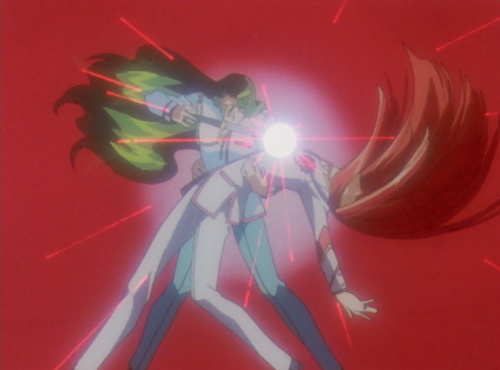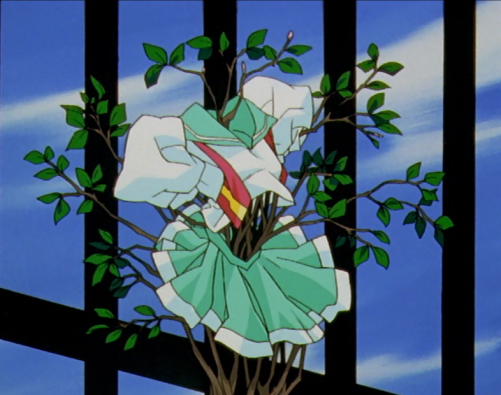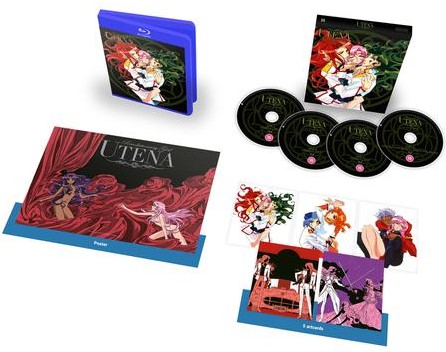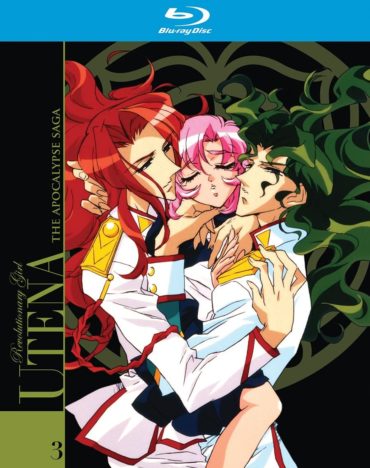Revolutionary Girl Utena: Part 3 Review
As Saionji makes his return to Ohtori Academy and back into the Student Council, the End of the World sends new letters to the council with notice that the Revolution is approaching, but not all of the student council are as driven as they were before. At rock bottom, each member hears a car, and are whisked off to take a cruise with the End of the World himself, revealed to be Akio – Anthy’s brother – and reveal a glimpse into what they need to keep duelling. Meanwhile, Utena and Anthy move into the Chairman’s house with their own room, and as Utena becomes closer to Akio, her duels get more intense and her relationship with Anthy also begins to change. But will she find her prince in the end? Or something far more Revolutionary?
Part 3 of the Anime Limited Blu-ray release contains Episodes 25 to 39 of the original TV series plus the 1999 film Adolescence of Utena. On the cover it calls the whole set ‘The Apocalypse Saga’ but it actually contains both the Akio Ohtori Saga (Episodes 25 to 33) with the Apocalypse Saga happening in the remaining episodes, but aside from the middle being broken up by a recap episode (that’s far more than the sum of its parts, just like the previous two in the series) the two Sagas actually bleed into each other and continue the themes and motifs that the series has been building up.

The previous Saga, Black Rose, made many hints at Anthy’s unusual powers and Akio’s secretive nature, but this Saga gives them more focus with the Student Council being Utena’s main opponents in the duels once again, but with a twist. The gimmick this time is that when a Council member starts to doubt they will be able to, or even want the power to Revolutionise the world, they start to hear the sound of a car. The car, with Akio as the driver, races into their world and the characters have a revealing speech before being given a glimpse of what the power of Revolution can mean for them. This leads them to ask Utena for a rematch, with their newfound drive (pun intended) and power to draw a sword from a person closest to them. The Black Rose Saga also had the ‘pull sword out of someone’ but it was shown as non-consensual with the person who had the sword pulled out of them often feeling embarrassed afterwards. This time, the sword pulling is mutually agreed upon, re-enacting the same poses and flair for the dramatics that Utena and Anthy perform. The sword pulling and drawing from each other for strength has sexual and romantic subtext to it, but there’s also many scenes where the characters are in the car beside Akio and either talk about sex or at least heavily hint at it. Then there’s plenty of scenes where the likes of Touga and Saionji poses provocatively for Akio next to the shiny car, unbuttoning their shirts as Akio snaps photos of them.
On the surface, it all seems rather ridiculous, especially the scenes where Touga and Sainonji look like boy band members posing for photos to sell to their many female fans, but like the elevator in the Black Rose Saga, asking characters to go deeper (meaning both in the elevator and into their own souls) the sexualised framing and cars makes sense in their own abstract way. As teenagers, what did we want most? Freedom to go and do whatever we wanted, to explore ourselves as well as the world around us – hence the car – we all wanted a car when we were younger, not just because it was cool to own one, but because with a car you can go wherever you desire. Also, as teens, discovering your sexual awakening is part of the journey, often an uncomfortable and painful one. Similarly we often mistake ‘being sexy’ as equating with ‘being adult’ – there’s a reason that many pop stars from Britney Spears to Miley Cyrus went from being all cute and innocent to suddenly loud and sexy, ‘cos they wanted to tell the world they’re not ‘little girls’ anymore but ‘women’. But of course, being sexy and owning a car do not automatically make you an adult, and as a teen we rarely think of the long-term consequences of such things. Cars have MOTs and insurance to think of, which is a lifelong commitment and responsibility, on top of being capable of causing great damage in a vehicle if you don’t know how to control it. As for sex, there’s the emotional weight that comes through it, risk of pregnancy, as well as being vulnerable in a way that’s unlike any other. But they are part of growing up and Utena, like the council members, is going through it her own way. Unfortunately, she has the series’ main villain, Akio, guiding her through these changes and this is where the series’ darkest themes – emotional manipulation, statutory rape, incest and more – come to play in these Sagas.
Then at the real start of the Apocalypse Saga, Episode 34, we finally get a backstory episode for Utena. Her story of meeting a prince and eventually being inspired to become one herself has been peppered across the series since the story began, with alternative points of view from Touga and Saionji thrown into the mix. But it’s here that we finally get to see the true story, framed like a play within the school grounds, but it’s an eye opener of an episode that sweeps up all the themes we’ve had since Episode 1 into an explosion of visual splendour and heartbreak for our heroines. The remaining 5 episodes of the show are a roller-coaster of plot twists, emotions and character turns, and the finale is one of the best that the anime genre has to offer – an emotionally cathartic end to a journey worth traveling. It’s more of a satisfying watch, however, if you have been following the symbolism to that point. Story-wise, if you’re just taking it at face value, it can feel more bittersweet, as if someone’s just pulled the rug from underneath you, but it’s still a great conclusion that holds up even to this day.

And I haven’t even talked about the movie yet! The finale aired in Japan way back in late 1997 and during its broadcast, director Kunihiko Ikuhara was inspired to create a movie as a retelling of the series with the themes and subject cranked up to 100! The film itself is NOT beginner-friendly, I should know because I actually reviewed it’s original release by MVM way back in 2010 and it’s clear from my (rather embarrassing) review that I had no idea what was going on, because back then I had not seen the series. Do I understand the movie now? Sort of. Better… Maybe? The film is 87 minutes long and as a result is cuts out a lot of the original series story, and despite several interviews found on these Blu-ray sets where Mr Ikuhara wanted to appeal to fans and non-fans, the movie pretty much expects you to fill in some knowledge from the show into the movie experience. But that doesn’t mean that it’s a copy-and-paste job with a bigger frame size and budget, the story is different enough in very important ways that I had to semi-switch off my knowledge of the TV series to prevent confusion and overload. The prince that inspires Utena is different, Anthy is a lot more forward in terms of sexuality and open with her past, and a large chunk of the cast is cut out. The movie however is very telling in a multitude of ways; one being that it’s funny how I completely forgot that the ‘comic relief’ characters Nanami and ChuChu weren’t even in the movie until the one scene they randomly appear at the mid-way point, and also how little that has to do with the themes and Utena’s story as a whole. The other is that a lot of the symbolism and messages from the TV series are re-contextualised into a new way in the movie; the ‘prince’ that Utena strives to be, for example, is not deconstructed in the same way, but instead is given a more sympathetic and tragic ending. Thirdly and lastly, the movie, to me at least, feels like it gives the fans of the heroines a happier ending and scenes that remove any doubt on the nature of their relationship, which in itself is a nice present from said director, and also why it’s still remembered both for it’s meme-worthy ending where Utena turns into a car, and for LGBT+ fans who want positive Queer representation outside of this decade.
Most long-running anime often have issues when it comes to the budget starting to run out towards the end of the show’s run, so a lot of corners are cut in order to make sure the anime ends the story properly, rather than end (similar to Evangelion) with concept art and squiggles. Revolutionary Girl Utena, somehow, gains budget in this part of the story. Whether it was due to its popularity, or that the staff (having learnt from their past experiences) just knew how to budget, but the animation quality steps up in these batches of episodes. First of all, we get a whole new tower-climbing clip-montage when Utena heads towards to duel, which is far more visually mesmerizing that feels something that the director wanted from the beginning, and we even get a whole new ending song with three different animations depending on where we are in the story.
On disc extras include the conclusion to multi-part interview continued from the second Blu-ray set, there are additional interviews with the director ,plus the English and Japanese cast, plus promos, clean endings, and karaoke for the duel songs, which is a lovely touch but sadly are in SD and the karaoke lyrics are in kanji so you’ll have to print out a translation/romaji copy to sing along yourself! On the movie disc you’ll have director’s commentary, trailers, and a behind the scenes look at Kunihiko Ikuhara directing the English dub himself. The collector’s edition also comes with new art cards and a poster.
So, we’ve come to the end of Revolutionary Girl Utena, and, despite its age, lacking animation at the start, lacklustre comedy and the wait we’ve had to finally have the full experience available in the UK, it’s been very much worth it. It’s the themes, symbolism, characters, music and sheer unique experience like no other that makes this shojo series continue to be one of the best in the genre. It is a classic that deserves to be called a classic, and true to its name, it’s revolutionary.



